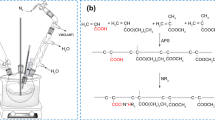Abstract
To improve the weatherability and antibacterial property of acrylic emulsion, a new kind of acrylic emulsion with UV-shielding and antibacterial properties was prepared by soap-free emulsion polymerization with (3-acrylamidopropyl)trimethyl ammonium chloride (ATAC) and 2- [3-(2H-Benzotriazol-2-yl)-4-hydroxyphenyl] ethyl methacrylate (BHEM) as functional monomers. A series of testing methods, including transmission electron microscopy (TEM), zeta potential, dynamic light scattering (DLS), gel permeation chromatography (GPC), Fourier transform infrared spectrum (FT-IR), ultraviolet absorption spectrum (UV), X-ray photoelectron spectroscopy (XPS), artificial accelerated aging test and antibacterial test, were adopted to characterize the emulsion and its coating. Results based on the characterization indicated that the particle size and zeta potential of the emulsion were 82.68 nm and 26.5 mv respectively, and its polydispersity index (PDI) was 1.4076. The emulsion was modified by the functional monomers and endowed it with good antibacterial property and strong UV-shielding performance at 295 nm and 340 nm. After 240 h aging test, the color difference (ΔE) and rate of loss of gloss (ΔG) of the coating made by the new emulsion were only 2.81 and 5.12% respectively, which were much lower than 16.85 and 52.43% of the unmodified coating. The antibacterial test showed that only a few colonies appeared on the surface of the medium coated with the new emulsion after 24 h incubation, while dozens of colonies were appeared in the control groups.











Similar content being viewed by others
References
Zhang X, Wen W, Yu H, Chen Q, Xu J, Yang D, Qiu F (2016) Preparation and artificial ageing tests in stone conservationof fluorosilicone vinyl acetate/acrylic/epoxy polymers. Chem Pap 70:1621–1631
Zhang X, Wen W, Yu H, Qiu F, Chen Q, Yang D (2016) Preparation, characterization of nano-silica/fluoroacrylate material and the application in stone surface conservation. J Polym Res 23:75
Bao Y, Ma J, Zhang X, Shi C (2015) Recent advances in the modification of polyacrylate latexes. J Mater Sci 50:6839–6863
Shi H, Liu W, Liu C, He S, Jiang C, Wang Z (2019) UV-curable waterborne epoxy acrylate coating modified by monomethacryloyloxy-terminated fluorinated oligomer. J Coat Technol Res 16:1305–1316
Park J, Jeon J, Lee Y, Lee D, Park H, Chun H, Kim H (2015) Synthesis and properties of UV-curable polyurethane acrylates containing fluorinated acrylic monomer/ vinyltrimethoxysilane. Polym Bull 72:1921–1936
Yang X, Qiu L, Shen Y, Wang C, Li P (2020) Preparation and properties of a novel waterborne fluorinated polyurethane–acrylate hybrid emulsion modified by long aliphatic chains. Polym Bull 77:2249–2267
Kumar D, Li L, Chen Z (2016) Mechanically robust polyvinylidene fluoride (PVDF) based superhydrophobic coatings for self-cleaning applications. Prog Org Coat 101:385–390
Alessandrini G, Aglietto M, Castelvetro V, Ciardelli F, Peruzzi R, Toniolo L (2000) Comparative evaluation of fluorinated and unfluorinated acrylic copolymers as water-repellent coating materials for stone. J Appl Polym Sci 76:962–977
Ershad-Langroudi A, Fadaei H, Ahmadi K (2019) Application of polymer coatings and nanoparticles in consolidation and hydrophobic treatment of stone monuments. Iran Polym J 28:1–19
Judzewitsch P, Corrigan N, Trujillo F, Xu J, Moad G, Hawker C, Wong E (2020) High-throughput process for the discovery of antimicrobial polymers and their upscaled production via flow polymerization. Macromolecules 53:631–639
Li C, Ma W, Ren X (2019) Synthesis and application of benzotriazole UV absorbers to improve the UV resistance of polyester fabrics. Fiber Polym 20:2289–2296
Dong W, Zhou L, Guo Y, Tang Y, Pan R, Liu M, He D (2022) Modification of styrene-acrylic emulsion by organic UV absorber in synergy with fluorine and silicon monomers for weatherable coatings. J Coat Technol Res 19(2):607–616
Hegstad K, Langsrud S, Lunestad B, Scheie A, Sunde M, Yazdankhah S (2010) Does the Wide Use of Quaternary Ammonium Compounds Enhance the Selection and Spread of Antimicrobial Resistance and Thus Threaten Our Health? Microb Drug Resist 16:91–104
Lu G, Wu D, Fu R (2007) Studies on the synthesis and antibacterial activities of polymeric quaternary ammonium salts from dimethylaminoethyl methacrylate. React Funct Polym 67:355–366
Chen Z, Wang Q, Zhang Z, Lei H (2021) Preparation and properties of antibacterial fluorinated acrylic emulsion. React Funct Polym 163:104901
Tamilvanan S, Ajith Kumar B, Senthilkumar S, Baskar R, Sekharan T (2010) Stability assessment of injectable castor oil-based nano-sized emulsion containing cationic droplets stabilized by poloxamer–vhitosan emulsifier films. AAPS PharmSciTech 11:02
Lei H, He D, Guo Y, Tang Y, Huang H (2018) Synthesis and characterization of UV-absorbing fluorine-silicone acrylic resin polymer. Appl Surf Sci 442:71–77
Gilbert P, Moore L (2005) Cationic antiseptics: diversity of action under a common epithet. J Appl Microbiol 99:703–715
Acknowledgements
This work was supported by the Provincial College Students Innovation and Entrepreneurship Training Program of Hunan province in China (JDCX2021458), National College Students Innovation and Entrepreneurship Training Program in China (202210531001), Scientific Research Fund of Hunan Provincial Education Department (22B0551), and Natural Science Foundation of Hunan Province (2020JJ4506).
Author information
Authors and Affiliations
Corresponding author
Ethics declarations
Conflicts of interest
On behalf of all authors, the corresponding author states that there is no conflict of interest.
Additional information
Publisher's Note
Springer Nature remains neutral with regard to jurisdictional claims in published maps and institutional affiliations.
Rights and permissions
Springer Nature or its licensor (e.g. a society or other partner) holds exclusive rights to this article under a publishing agreement with the author(s) or other rightsholder(s); author self-archiving of the accepted manuscript version of this article is solely governed by the terms of such publishing agreement and applicable law.
About this article
Cite this article
Huang, X., Chen, J., Zhu, L. et al. Synthesis and characterization of a new acrylic emulsion with dual efficacy: UV-shielding and antibacterial function. J Polym Res 30, 263 (2023). https://doi.org/10.1007/s10965-023-03659-w
Received:
Accepted:
Published:
DOI: https://doi.org/10.1007/s10965-023-03659-w




